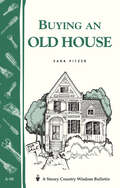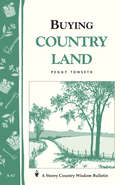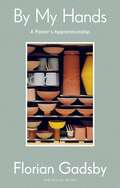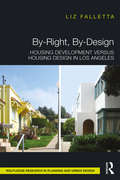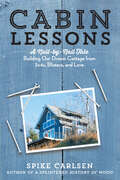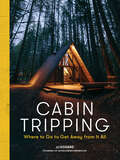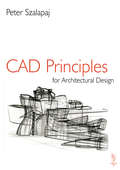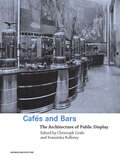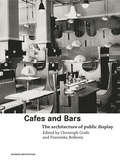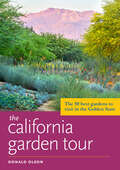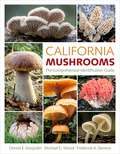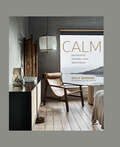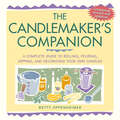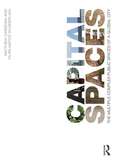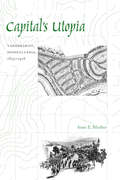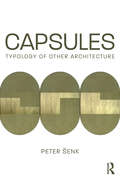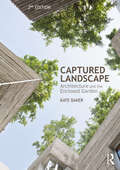- Table View
- List View
Buying an Old House: Storey Country Wisdom Bulletin A-88 (Storey Country Wisdom Bulletin)
by Sara PitzerSince 1973, Storey's Country Wisdom Bulletins have offered practical, hands-on instructions designed to help readers master dozens of country living skills quickly and easily. There are now more than 170 titles in this series, and their remarkable popularity reflects the common desire of country and city dwellers alike to cultivate personal independence in everyday life.
Buying Country Land: Storey Country Wisdom Bulletin A-67 (Storey Country Wisdom Bulletin)
by Peggy TonsethSince 1973, Storey's Country Wisdom Bulletins have offered practical, hands-on instructions designed to help readers master dozens of country living skills quickly and easily. There are now more than 170 titles in this series, and their remarkable popularity reflects the common desire of country and city dwellers alike to cultivate personal independence in everyday life.
By My Hands: A Potter’s Apprenticeship
by Florian Gadsby'Every page made me wish I was a potter' Nigel SlaterFlorian Gadsby has devoted his life to pottery, refining his technique towards the point of perfection - and as his skill has grown, so has his social media following, which today numbers in the millions. Based at a studio in North London, he releases three new collections per year, characterized by simple forms and sharp edges, which sell out in a matter of minutes.In By My Hands, Florian tells the story of his artistic awakening, his education in England, Ireland and Japan, and of the sheer discipline which has led him to become the cultural sensation he is today. Arguing for the value in dedicating yourself to a craft, Florian weaves anecdotes about particular pots and processes into the narrative of his life, exploring what he has learnt from specific pieces he was taught to throw during his apprenticeships and how they have informed his philosophy and approach to his work.By My Hands is an ode to the beauty of small things, such as a simple hand-thrown mug or bowl, which can brighten life's daily rituals and make them more meaningful - as well as an inspiring testament to the power of perseverance.
By-Right, By-Design: Housing Development versus Housing Design in Los Angeles
by Liz FallettaHousing is an essential, but complex, product, so complex that professionals involved in its production, namely, architects, real estate developers and urban planners, have difficulty agreeing on “good” housing outcomes. Less-than-optimal solutions that have resulted from a too narrow focus on one discipline over others are familiar: high design that is costly to build that makes little contribution to the public realm, highly profitable but seemingly identical “cookie-cutter” dwellings with no sense of place and well-planned neighborhoods full of generically designed, unmarketable product types. Differing roles, languages and criteria for success shape these perspectives, which, in turn, influence attitudes about housing regulation. Real estate developers, for example, prefer projects that can be built “as-of-right” or “by-right,” meaning that they can be approved quickly because they meet all current planning, zoning and building code requirements. Design-focused projects, heretofore “by-design,” by contrast, often require time to challenge existing regulatory codes, pursuing discretionary modifications meant to maximize design innovation and development potential. Meanwhile, urban planners work to establish and mediate the threshold between by-right and by-design processes by setting housing standards and determining appropriate housing policy. But just what is the right line between “by-right” and “by-design”? By-Right, By-Design provides a historical perspective, conceptual frameworks and practical strategies that cross and connect the diverse professions involved in housing production. The heart of the book is a set of six cross-disciplinary comparative case studies, each examining a significant Los Angeles housing design precedent approved by-variance and its associated development type approved as of right. Each comparison tells a different story about the often-hidden relationships among the three primary disciplines shaping the built environment, some of which uphold, and others of which transgress, conventional disciplinary stereotypes.
By-Right, By-Design: Housing Development versus Housing Design in Los Angeles
by Liz FallettaHousing is an essential, but complex, product, so complex that professionals involved in its production, namely, architects, real estate developers and urban planners, have difficulty agreeing on “good” housing outcomes. Less-than-optimal solutions that have resulted from a too narrow focus on one discipline over others are familiar: high design that is costly to build that makes little contribution to the public realm, highly profitable but seemingly identical “cookie-cutter” dwellings with no sense of place and well-planned neighborhoods full of generically designed, unmarketable product types. Differing roles, languages and criteria for success shape these perspectives, which, in turn, influence attitudes about housing regulation. Real estate developers, for example, prefer projects that can be built “as-of-right” or “by-right,” meaning that they can be approved quickly because they meet all current planning, zoning and building code requirements. Design-focused projects, heretofore “by-design,” by contrast, often require time to challenge existing regulatory codes, pursuing discretionary modifications meant to maximize design innovation and development potential. Meanwhile, urban planners work to establish and mediate the threshold between by-right and by-design processes by setting housing standards and determining appropriate housing policy. But just what is the right line between “by-right” and “by-design”? By-Right, By-Design provides a historical perspective, conceptual frameworks and practical strategies that cross and connect the diverse professions involved in housing production. The heart of the book is a set of six cross-disciplinary comparative case studies, each examining a significant Los Angeles housing design precedent approved by-variance and its associated development type approved as of right. Each comparison tells a different story about the often-hidden relationships among the three primary disciplines shaping the built environment, some of which uphold, and others of which transgress, conventional disciplinary stereotypes.
By the Seaside: By The Seaside Library Ebook (Popcorn: Where I Live)
by Honor HeadA colourful introduction for young readers to the seaside. The young boy, Alex, tells us all about his home town at the seaside and the things in his local area such as his school, what he does after school, going to the seafront and the beach, what he does at the weekend, the different jobs people do there, different sorts of shops that are at in seaside towns and how people get about.Includes a picture quiz and free downloadable worksheets.This book encourages children to think about the similarities and differences between the place where they live and where other people live.
Cabin Lessons: A Nail-by-Nail Tale: Building Our Dream Cottage from 2x4s, Blisters, and Love
by Spike CarlsenWhen carpenter Spike Carlsen and his wife set out with their recently blended family of five kids to build a cabin on the north shore of Lake Superior, they quickly realized that painting, parenting, and putting up drywall all come with both frustrations and unexpected rewards. Part building guide and part memoir, Cabin Lessons tells the wryly funny, heartwarming story of their eventful journey — from buying an unforgiving plot of land on an eroding cliff to (finally) enjoying the lakeside hideaway of their dreams.
Cabin Tripping: Where to Go to Get Away from It All
by JJ EggersA lushly photographed and detailed inspirational gift book featuring over 80 spectacular cabins around the world, all available to rent.
Cactus (UEB contracted)
by RnibThere are two images of the Pachycereus pringlei cactus on this page.There is a locator dot shown, which will be at the top left of the page when the image is the correct way up.In the top right of the page is a small image, with a border, of a large branching cactus dwarfing a person standing to the right of it. This shows how large the plant can grow; the tallest found is 19.2 metres (63 feet) high.Most of the page is filled by an image of a young cactus with a single stem, shown at actual size. The plant is rooted in the soil at the bottom of the page. The plans stem is shaped like a squat column with a rounded top in the top part of the page. It has clusters of spines on its surface, which help it cut water loss in its hot, dry desert environment by slowing the flow of air around it.The cactus has ridges going vertically up its stem, giving it a star-shaped cross section. This allows the plant to expand and fill up with water during rainy periods.The cactus is a dicotyledon.
Cactus (UEB uncontracted)
by RnibThere are two images of the Pachycereus pringlei cactus on this page.There is a locator dot shown, which will be at the top left of the page when the image is the correct way up.In the top right of the page is a small image, with a border, of a large branching cactus dwarfing a person standing to the right of it. This shows how large the plant can grow; the tallest found is 19.2 metres (63 feet) high.Most of the page is filled by an image of a young cactus with a single stem, shown at actual size. The plant is rooted in the soil at the bottom of the page. The plans stem is shaped like a squat column with a rounded top in the top part of the page. It has clusters of spines on its surface, which help it cut water loss in its hot, dry desert environment by slowing the flow of air around it.The cactus has ridges going vertically up its stem, giving it a star-shaped cross section. This allows the plant to expand and fill up with water during rainy periods.The cactus is a dicotyledon.
CAD Principles for Architectural Design
by Peter SzalapajCAD Principles for Architectural Design is aimed at design students and practitioners interested in understanding how CAD is used in architectural practice. This book makes connections between the basic operations that are common to most CAD systems, and their use in practice on actual architectural design projects. The ways in which CAD is integrated into the design processes of several leading edge practices is illustrated. Arising from these case studies is the emergence of a contemporary phenomenon of integrated CAD, in which all aspects of design schemes are brought together within computational frameworks that support the analysis of design proposals.Szalapaj's view of CAD is one in which computers constitute a medium in which designers can express design ideas, rather than viewing computers as problem solving machines. For creative designers to successfully exploit CAD technology, CAD systems should reflect designers' intuitions as described by designers themselves
CAD Principles for Architectural Design
by Peter SzalapajCAD Principles for Architectural Design is aimed at design students and practitioners interested in understanding how CAD is used in architectural practice. This book makes connections between the basic operations that are common to most CAD systems, and their use in practice on actual architectural design projects. The ways in which CAD is integrated into the design processes of several leading edge practices is illustrated. Arising from these case studies is the emergence of a contemporary phenomenon of integrated CAD, in which all aspects of design schemes are brought together within computational frameworks that support the analysis of design proposals.Szalapaj's view of CAD is one in which computers constitute a medium in which designers can express design ideas, rather than viewing computers as problem solving machines. For creative designers to successfully exploit CAD technology, CAD systems should reflect designers' intuitions as described by designers themselves
Cafes and Bars: The Architecture of Public Display (Interior Architecture)
by Christoph Grafe Franziska BollereyThe design of bars and cafes has played an important role in the development of architecture in the twentieth century. This influence has been felt particularly strongly over the past thirty years, in a time when these social spaces have contributed significantly to the rediscovery and reinvention of cities across Europe and North America. This volume presents and examines this significant urban architectural production, and discusses it against a background of the design of cafes and bars across the nineteenth and twentieth centuries. Major themes and developments are discussed and illustrated with case studies, from the functionalist pre-World War Two architects in Central Europe representing modern society through the design of public spaces, right up to the design of sophisticated bars and cafes as part of the recent urban renaissance of Barcelona and Paris in 1980s and London in the '90s.
Cafes and Bars: The Architecture of Public Display (Interior Architecture)
by Christoph Grafe Franziska BollereyThe design of bars and cafes has played an important role in the development of architecture in the twentieth century. This influence has been felt particularly strongly over the past thirty years, in a time when these social spaces have contributed significantly to the rediscovery and reinvention of cities across Europe and North America. This volume presents and examines this significant urban architectural production, and discusses it against a background of the design of cafes and bars across the nineteenth and twentieth centuries. Major themes and developments are discussed and illustrated with case studies, from the functionalist pre-World War Two architects in Central Europe representing modern society through the design of public spaces, right up to the design of sophisticated bars and cafes as part of the recent urban renaissance of Barcelona and Paris in 1980s and London in the '90s.
The California Garden Tour: The 50 Best Gardens to Visit in the Golden State
by Donald OlsonIn The California Garden Tour veteran travel writer Donald Olson brings his style, wit, and insight to the public gardens of the Golden State. You'll discover the 50 most beautiful and iconic gardens to visit all across the state.
California Mushrooms: The Comprehensive Identification Guide
by Dennis E. Desjardin Michael G. Wood Frederick A. StevensCalifornia Mushrooms is a comprehensive guide, providing information on when and where to find mushrooms; guidelines on how to collect and identify mushrooms; keys to species; and overviews of nomenclature and taxonomy, morphology and phylogeny, fungal ecology, biology, and mushroom toxins.
Calm
by Sally DenningIn recent times, many of us have spent more time at home than ever before. Creating a home that instills a sense of calm will cocoon and protect us from the outside world, create a sense of wellbeing and make us feel truly nurtured. Calm will help you create a restful, restorative interior that draws you in and makes your shoulders drop the moment you walk through the door. Sally Denning first explores the essential foundations of a tranquil, comforting home: calming and harmonious colours, textiles, pattern, lighting and decorative elements. She goes on to explore a mix of accessible real-life homes, ranging from city homes to country houses, new builds, flats/apartments, beach houses and more. The spaces may be different, but they all share one thing: a timeless, soothing and restful atmosphere that is a pleasure to come home to.
The Candlemaker's Companion: A Complete Guide to Rolling, Pouring, Dipping, and Decorating Your Own Candles
by Betty OppenheimerEnjoy some homemade glow. From wax to wick to wrapping, The Candlemaker&’s Companion is a definitive guide to modern candle making. Learn how to create rolled, poured, molded, and dipped candles; play with your favorite scents and colors; and use specialty techniques to design glowing luminaria, candle holders, and other gorgeous accessories. With illustrated directions, complete source lists, and plenty of practical advice, Betty Oppenheimer invites even the beginner candlemaker to get in on the action. Fill your house with the warm light and enticing fragrances that only candles can bring.
Capital Spaces: The Multiple Complex Public Spaces of a Global City
by Matthew Carmona Filipa Matos WunderlichIn recent years it has become common-place to hear claims that public space in cities across the globe has become the exclusive preserve of the wealthy and privileged, at the expense of the needs of wider society. Whether it is the privatization of public space through commerical developments like shopping malls and business parks, the gentrification of existing spaces by campaigns against perceived anti-social behaviour or the increasing domination of public areas by private transport in the form of the car, the urban public space is seen as under threat. But are things really that bad? Has the market really become the sole factor that influences the treatment of public space? Have the financial and personal interests of the few really come to dominate those of the many? To answer these questions Matthew Carmona and Filipa Wunderlich have carried out a detailed investigation of the modern public spaces of London, that most global of cities. They have developed a new typology of public spaces applicable to all cities, a typology that demonstrates that to properly assess contemporary urban places means challenging the over-simplification of current critiques. Global cities are made up of many overlapping public spaces, good and bad; this book shows how to analyze this complexity, and to understand it.
Capital Spaces: The Multiple Complex Public Spaces of a Global City
by Matthew Carmona Filipa Matos WunderlichIn recent years it has become common-place to hear claims that public space in cities across the globe has become the exclusive preserve of the wealthy and privileged, at the expense of the needs of wider society. Whether it is the privatization of public space through commerical developments like shopping malls and business parks, the gentrification of existing spaces by campaigns against perceived anti-social behaviour or the increasing domination of public areas by private transport in the form of the car, the urban public space is seen as under threat. But are things really that bad? Has the market really become the sole factor that influences the treatment of public space? Have the financial and personal interests of the few really come to dominate those of the many? To answer these questions Matthew Carmona and Filipa Wunderlich have carried out a detailed investigation of the modern public spaces of London, that most global of cities. They have developed a new typology of public spaces applicable to all cities, a typology that demonstrates that to properly assess contemporary urban places means challenging the over-simplification of current critiques. Global cities are made up of many overlapping public spaces, good and bad; this book shows how to analyze this complexity, and to understand it.
Capital's Utopia: Vandergrift, Pennsylvania, 1855-1916 (Creating the North American Landscape)
by Anne E. MosherIn the 1890s the Apollo Iron and Steel Company ended a bitterly contested labor dispute by hiring replacement workers from the surrounding countryside. To avoid future unrest, however, the company sought to gain tighter control over its workers not only at the factory but also in their homes. Drawing upon a philosophy of reform movements in Europe and the United States, the firm decided that providing workers with good housing and a good urban environment would make them more loyal and productive. In 1895, Apollo Iron and Steel built a new, integrated, non-unionized steelworks and hired the nation's preeminent landscape architectural firm (Olmsted, Olmsted, and Eliot) to design the model industrial town: Vandergrift.In Capital's Utopia: Vandergrift, Pennsylvania, 1855-1916, Anne E. Mosher offers the first comprehensive geographical overview of the industrial restructuring of an American steelworks and its workforce in the late nineteenth–century. In addition, by offering a thorough analysis of the Olmsted plan, Mosher integrates historical geography and labor history with landscape architectural history and urban studies. As a result, this book is far more than a case study. It is a window into an important period of industrial development and its consequences on communities and environments in the world-famous steel country of southwestern Pennsylvania.
Capsules: Typology of Other Architecture
by Peter ŠenkThis book investigates the architectural, product design, and urban typology of the capsule which, beginning in the 1960s, broadened the concept of the basic building blocks of architecture to include a minimal living unit, called the "capsule." Here it is presented with regard to the continuity of the development of the Modern Movement, its revisionist criticism, pioneering examples, as well as contemporary examples and uses. The typology of the capsule allows us to consider this theme in terms of the architecture of resistance, with the potential to search for an "other" architecture that is embedded in our contemporaneity (manifested in small dwellings, composite structures, and container units; shelters and mobile homes in nature and the urban environment; technology transfer in high-tech designs; devices, additions, and extensions etc.). The concept of the capsule as a building element of architecture, as well as a spatial element, can therefore be regarded as having a generative potential for an architecture of personal space for the individual, forcing us to reflect on our existing living and dwelling conditions.
Capsules: Typology of Other Architecture
by Peter ŠenkThis book investigates the architectural, product design, and urban typology of the capsule which, beginning in the 1960s, broadened the concept of the basic building blocks of architecture to include a minimal living unit, called the "capsule." Here it is presented with regard to the continuity of the development of the Modern Movement, its revisionist criticism, pioneering examples, as well as contemporary examples and uses. The typology of the capsule allows us to consider this theme in terms of the architecture of resistance, with the potential to search for an "other" architecture that is embedded in our contemporaneity (manifested in small dwellings, composite structures, and container units; shelters and mobile homes in nature and the urban environment; technology transfer in high-tech designs; devices, additions, and extensions etc.). The concept of the capsule as a building element of architecture, as well as a spatial element, can therefore be regarded as having a generative potential for an architecture of personal space for the individual, forcing us to reflect on our existing living and dwelling conditions.
Captured Landscape: Architecture and the Enclosed Garden
by Kate BakerThe enclosed garden, or hortus conclusus, is a place where architecture and landscape come together. It has a long and varied history, ranging from the early paradise garden and cloister, the botanic garden and giardini segreto, the kitchen garden and as a stage for social display. The enclosed garden has continued to develop into its many modern forms: the city retreat, the redemptive garden, the deconstructed building. As awareness of climate change becomes increasingly important, the enclosed garden, which can mediate so effectively between interior and exterior, provides opportunities for sustainable design and closer contact with the natural landscape. By its nature it is ambiguous. Is it an outdoor room, or captured landscape; is it architecture or garden? Kate Baker discusses the continuing relevance of the typology of the enclosed garden to contemporary architects by exploring influential historical examples and the concepts they generate, alongside some of the best of contemporary designs – brought to life with vivid photography and detailed drawings – taken primarily from Britain, the Mediterranean, Japan and North and South America. She argues that understanding the potential of the enclosed garden requires us to think of it as both a design and an experience. Captured Landscape provides a broad range of information and design possibilities for students of architectural and landscape design, practising architects, landscape designers and horticulturalists and will also appeal to a wider audience of all those who are interested in garden design. This second edition of Captured Landscape is enriched with new case studies throughout the book. The scope has now been broadened to include an entirely new chapter concerning the urban condition, with detailed discussions on issues of ecology, sustainability, economy of means, well-being and the social pressures of contemporary city life.
Captured Landscape: Architecture and the Enclosed Garden
by Kate BakerThe enclosed garden, or hortus conclusus, is a place where architecture and landscape come together. It has a long and varied history, ranging from the early paradise garden and cloister, the botanic garden and giardini segreto, the kitchen garden and as a stage for social display. The enclosed garden has continued to develop into its many modern forms: the city retreat, the redemptive garden, the deconstructed building. As awareness of climate change becomes increasingly important, the enclosed garden, which can mediate so effectively between interior and exterior, provides opportunities for sustainable design and closer contact with the natural landscape. By its nature it is ambiguous. Is it an outdoor room, or captured landscape; is it architecture or garden? Kate Baker discusses the continuing relevance of the typology of the enclosed garden to contemporary architects by exploring influential historical examples and the concepts they generate, alongside some of the best of contemporary designs – brought to life with vivid photography and detailed drawings – taken primarily from Britain, the Mediterranean, Japan and North and South America. She argues that understanding the potential of the enclosed garden requires us to think of it as both a design and an experience. Captured Landscape provides a broad range of information and design possibilities for students of architectural and landscape design, practising architects, landscape designers and horticulturalists and will also appeal to a wider audience of all those who are interested in garden design. This second edition of Captured Landscape is enriched with new case studies throughout the book. The scope has now been broadened to include an entirely new chapter concerning the urban condition, with detailed discussions on issues of ecology, sustainability, economy of means, well-being and the social pressures of contemporary city life.
